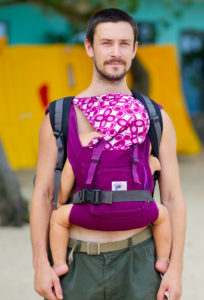
Ever since babies have been born, babies have been worn. Mom or dad or another caregiver carries the baby close to his/her body using a long piece of fabric or a structured carrier. Babywearing has been handed down through generations in many cultures. But in Western culture, it fell out of practice many generations ago. Recently, babywearing has become more common in our mainstream society.
One reason for this comeback is that many benefits are now known about babywearing.
Did you know?
- Babies who are worn cry less
- Babies who are worn can have greater speech development because they are surrounded by conversation
- Babies who are worn are more “organized” emotionally and can cope with stress and stimulation positively
- Babies who are worn become more confident and independent as they grow older
Unfortunately, many depictions of babywearing in the United States show unsafe ways to tote a tot. For example, the movie The Pacifier is famous for one of the main characters wearing a sweet baby boy on his chest. While cute, the way in which this baby is being worn could wreak havoc on the baby’s back and hips. This position has the baby’s legs dangling straight down. It can cause baby to arch his back into an unnatural posture. It can also pull his hips into dislocation or cause a condition called hip dysplasia.

Other examples of unsafe babywearing include paparazzi snapshots of celebrities wearing their babies. Commercials and TV shows often also depict unsafe ways to wear baby.
We have not had this tradition handed down to us by our grandparents. We have not seen it modeled in our family and community since our infancy. So it’s no surprise that mistakes like this are being made as we attempt to revive this wonderful way of soothing our babies.
Here are a few key pointers in safe babywearing so that mistakes are less likely to happen.
-

Baby should be kissable. Photo by Ferenc Horvath on Unsplash. Baby should be kissable. Baby should be high enough that the wearer can just bend his or her face down and be able to kiss the top of baby’s head.
- Following this rule also ensures that baby’s face is in view.
- Having baby’s face in view prevents breathing issues. It keeps baby’s face uncovered and keeps baby’s chin from being pressed down onto his chest.
- Baby’s legs should be in an “M” position and should not dangle straight down. In the womb, babies are used to their legs being folded up close to their bodies. This remains a comfortable and ergonomic position for newborns to continue. Older babies still need their legs to be bent while being worn to protect their hip joints and their spines.
- When a baby’s legs are hanging straight down, or “dangling,” it can pull his hips and spine into an unsafe position. For this reason, it is not recommended that babies face forward while on the wearers front. Worn this way, baby’s legs tend to dangle straight down.
- It is much safer to wear baby chest to chest with the carrier spread all the way across their bottom and knee to knee. This way, baby is in a sitting type position with his knees slightly higher than his bottom. Newborn babies can have their legs inside the carrier in the fetal position.
- Baby is held in nice and snug and supported. You want to make sure you’ve eliminated fall risks. Baby being nice and tight to your body will ease your mind about the possibility of her falling out of the carrier.
- Also, consider your baby’s head, neck, and back strength. If she needs the support, make sure the fabric covers and supports those areas. Babies or toddlers who can sit unassisted will need less coverage on their back and shoulders than those without that strength yet.
- This rule also helps to save the wearer’s back! Having baby tight to your body and nice and supported stops you from having to adjust your center of gravity to keep her balanced!
- Common Sense. It may seem silly to mention this, but this is one of the most important guidelines to follow when babywearing!
- Follow the manufacturer’s instructions for your carrier. Educate yourself on the art of babywearing.
- Ask other families with experience or a doula who is knowledgeable about babywearing. Take a class (if offered in your area) or search for reputable sources online. Looking for other families or help with babywearing in Madison, Wisconsin? Check out Babywearing International of Madison or contact me at First Care Clinic.
- Always use your own gut as a guide. If something feels “off” to you when you strap on that baby, then something likely is off. If you feel like you are having to hold your own body in an unnatural way, then baby probably is not as snug and secure as he should be. If you feel that baby is uncomfortable in her position she may need to be readjusted. (Note: Most babies will protest being put into their carriers. They will soon settle down once properly adjusted and rocked or soothed for a few minutes.) Put those parenting instincts to good use!

This article will get you started on your way to safe babywearing. It is not a complete and comprehensive guide! Please go out there and learn more about the tradition of babywearing. It is a wonderful, ancient practice that is not only practical, but very beneficial for both baby and caregiver!
For more information visit:
Or call or text me. I’d love to help you get started with wearing your baby.


